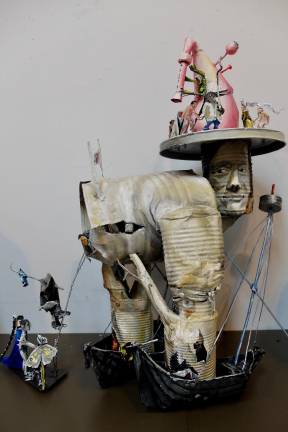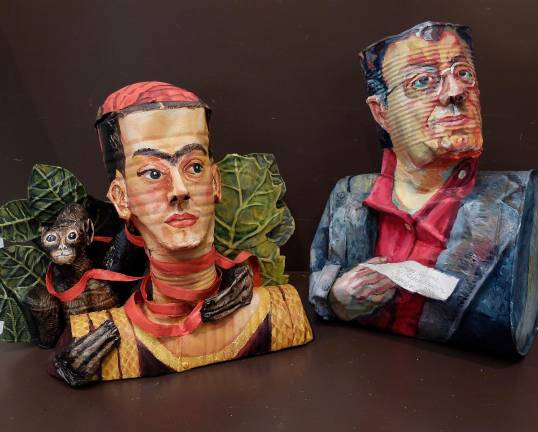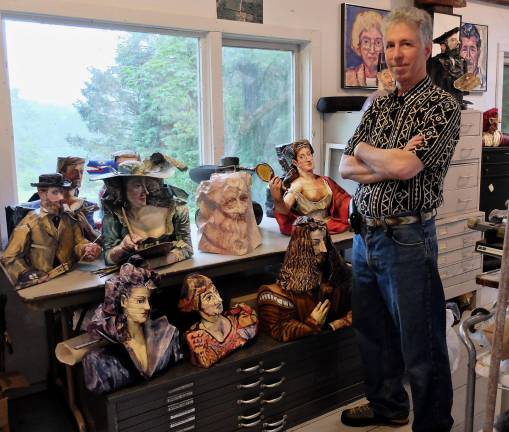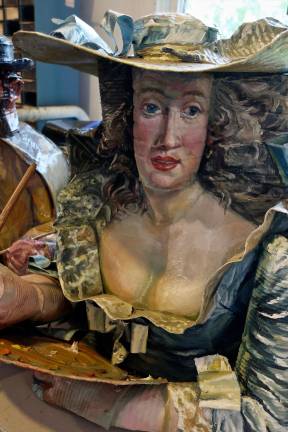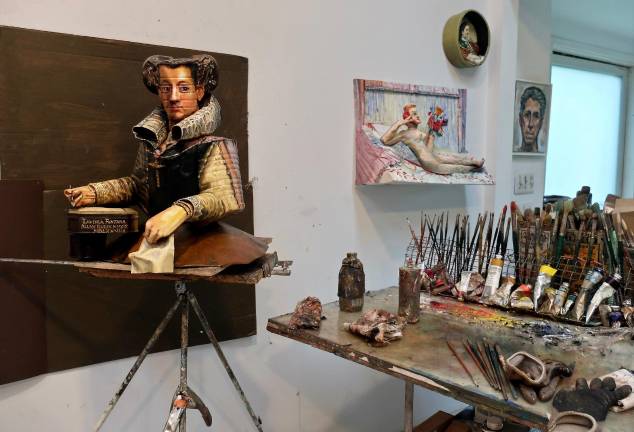Allan Rubin is never alone in his studio barn, perched on a hill with ”eight-mile-views” in Sullivan County. He is surrounded by a storied gallery of fellow artists. Many look familiar, but there’s a certain element of the uncanny about them. On closer inspection, the rippling folds of fabric or flesh have an underlying uniformity––say, the familiar ridged form of a 28-ounce can.
Canon (pun intended) is the most recent of Rubin’s art series. Working from self-portraits of renowned artists as his guide, he has made 84 sculptures and counting over three years, using recycled steel and aluminum cans as his raw material. He pays homage to artists he has learned from, and who played an important and influential role in their time period.
Rubin and his partner, fellow artist Candy Spilner, live a few miles from Bethel, site of the 1969 Woodstock Festival. Rubin didn’t go to Woodstock; he doesn’t like crowds. He was however, part of the vibrant downtown Manhattan art scene in the 70s and 80s.
Graduating with a degree in fine art from Cooper Union, he found success exhibiting and selling his paintings of surreal city scenes. Using a photo realistic style, he upended viewer expectations by combining streetscapes with aerial views to create a pigeon’s eye view of the world.
In many ways, Rubin and Spilner created the archetypal artists’ life for themselves in New York City. They worked three days a week as studio assistants for Tom Wesselmann, a painter and sculptor associated with the Pop art movement, and had four days a week for their own art.
One of Rubin’s gigs was to stretch canvases for other artists. He had inherited a knack for manipulating material from his father, a fur designer. “The canvas will do whatever I want it to do and be tight as a drum 30 years later,” said Rubin. Those skills opened doors for him: in addition to stretching canvases and mixing paint, he was soon managing artwork for big name New York artists the likes of Robert Motherwell and Chuck Close.
Rubin’s parents had bemoaned the fact that their son had not become a commercial artist, but ultimately he and Spilner saved enough money to buy an old farmhouse upstate with several acres of woodland and meadow, and barns that could be turned into studios. In the early 2000s they moved to the country full time.
Art is everywhere you look in the house – their own and friends’. Rubin points out a striking pair of multi-colored and patterned abstract sculptures, made from canvas stretched expertly over branches. “That’s Mom and Dad,” he says. “This is the sort of thing I was doing for 25 years before I discovered the cans: canvas on branches, oil portraits. The branches and I always had a dialogue; they wanted to do one thing and I wanted to do another and we compromised.”
The thread of adding contour and depth to two dimensional images is woven throughout Rubin’s career, from his early streetscapes, to large 3-D aerial maps built from branches and stretched canvas, and his most recent can sculptures. Perhaps it was living on the upper floors of city apartments that first sparked his interest in topography. “I’ve always wanted to be unique,” says Rubin, “doing things others weren’t doing.”
Five years ago, Rubin was looking for something to make and submit to the Art in Sixes annual holiday exhibition hosted by the Delaware Valley Arts Alliance in Narrowsburg, NY. The artwork can’t exceed six inches in any direction. His eye settled on a couple of cans of tomatoes — just the right size. First he primed the cans with house paint, then a layer of gesso, before setting to work with his oils to paint portraits of his cats. He had found his new medium.
In his studio, bags and boxes overflow with used cans from his kitchen or donated by friends – olive oil, grape leaves, coffee, beans, cat food cans. “Found and recycled material has always appealed to me,” Rubin says. “I like the idea of not putting a lot of trash in the waste stream.” He points out sculptures in his Canon series that are formed from scraps of flashing from his roof, a metal lunch pail and a mailbox.
It takes Rubin 40 hours to complete an average piece. Once he has settled on an artist self-portrait, he selects the can sizes that will work best. He couldn’t resist using a can of Botticelli olive oil for his portrait of Renaissance painter Sandro Botticelli. Using a basic set of tools — pliers, a pair of shears that belonged to his father, hammers and screws — Rubin cuts, bends, shapes and screws the metal together until he has a likeness. After the primer and gesso, he paints them with oils in the style of the original portrait. So far he hasn’t found an artist whose paint technique has stumped him.
Researching possible subjects, Rubin was struck by something. “At art school, in Janson’s History of Art textbook, there were no women painters. A travesty!” To right the imbalance, “I’m trying to make 50 percent of the canon female and non-Western artists.”
Along the way Rubin has exhibited the series and sold pieces. He’s made new sculptures to replace a couple of them, always choosing a different self-portrait of the artist to work from. When his portrait gallery reaches 100, he says he’ll pause and evaluate. He sees Canon as an educational tool and historical record, hoping one day that all his artist friends will be displayed together in a permanent exhibition space.
